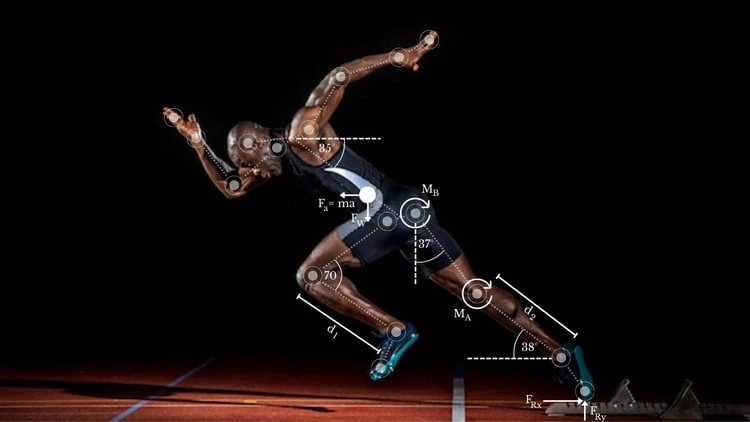Biomechanics and Injury Prevention in Athletes
Biomechanics is the scientific study of human movement, focusing on how muscles, bones, tendons, and ligaments work together to produce motion. In sports, understanding biomechanics is critical for improving performance and preventing injuries. Athletes constantly push their bodies to the limit, making them prone to overuse injuries, muscle imbalances, and poor movement patterns. By analyzing the mechanics of movement, coaches and sports scientists can identify inefficiencies and flaws in technique that may lead to injury.
Main Tools Used
Tools like motion-capture systems, force plates, and video analysis software allow for precise evaluation of an athlete’s movements, highlighting areas that require adjustment. This data-driven approach helps athletes make informed changes to their posture, alignment, and form, leading to improved efficiency and reduced injury risk.
One of the primary applications of biomechanics is motion analysis, which uses advanced technology to track joint angles, muscle activity, and body movements in real-time. Athletes are recorded while performing specific exercises or movements, and the data is analyzed to detect asymmetries, improper joint alignment, or excessive stress on particular areas of the body. For example, runners often undergo gait analysis to identify issues like overpronation, which can lead to knee or shin injuries. Similarly, pitchers in baseball can have their throwing mechanics analyzed to reduce strain on their shoulders and elbows. By correcting these inefficiencies, biomechanics not only enhances performance but also minimizes the risk of chronic injuries caused by repetitive movements.
Biomechanical Tools for Injury Prevention
| Tool/Technique | Purpose | Benefits |
|---|---|---|
| Motion-Capture Systems | Tracks body movements to analyze form and technique | Identifies inefficiencies, improving movement precision. |
| Force Plates | Measures forces exerted during movement or landing | Detects imbalances and reduces impact-related injuries. |
| Video Analysis Software | Provides visual breakdown of motion patterns | Allows athletes to visualize flaws and refine techniques. |
| EMG Sensors (Electromyography) | Measures muscle activity and activation patterns | Evaluates muscle imbalances and monitors rehabilitation progress. |
| 3D Gait Analysis | Analyzes walking and running patterns | Corrects posture and reduces stress on joints. |
| Pressure Mapping Systems | Measures pressure distribution on feet or other surfaces | Prevents injuries by detecting uneven load distribution. |
Posture Correction and Alignment for Injury Prevention
Proper posture and alignment are fundamental for athletes, as even minor imbalances can lead to significant stress on joints and muscles. Poor posture often results from muscle imbalances, lack of flexibility, or repetitive movements, all of which can cause overuse injuries over time. Biomechanics addresses these issues through postural assessments, where experts evaluate an athlete’s standing and dynamic alignment. Techniques like functional movement screening (FMS) help detect weaknesses, stiffness, or asymmetries in an athlete’s body. Once these problems are identified, corrective exercises and stretches are implemented to restore balance and symmetry.
For instance, athletes with tight hip flexors may compensate by overloading their lower backs, leading to lumbar pain. Through biomechanical analysis, these imbalances can be corrected with strengthening exercises for the glutes and core, combined with flexibility training for the hip flexors. Similarly, shoulder instability in swimmers can be addressed with specific rotator cuff strengthening routines and mobility drills. This emphasis on alignment ensures that forces are distributed evenly across joints and muscles, minimizing wear and tear and allowing athletes to move more efficiently.
Key Benefits of Biomechanics in Injury Prevention
- Early Detection of Risks: Identifies potential injury risks before they develop into serious problems.
- Improved Movement Efficiency: Ensures optimal movement patterns, reducing unnecessary strain on joints and muscles.
- Personalized Training Programs: Designs custom exercises to address individual weaknesses or imbalances.
- Faster Rehabilitation: Monitors progress during injury recovery, ensuring a safe return to sports.
- Enhanced Performance: Focuses on improving biomechanics, which translates to better technique and athletic output.
- Reduced Overuse Injuries: Prevents chronic issues caused by repetitive movements through motion analysis.
- Balanced Muscle Activation: Ensures even workload distribution to avoid muscular fatigue and imbalances.
- Long-Term Injury Prevention: Encourages sustainable movement habits, extending athletic careers.
Biomechanics and Sport-Specific Injury Prevention
Different sports pose unique biomechanical challenges, and injury prevention strategies must be tailored accordingly. For example, basketball players are prone to ankle and knee injuries due to frequent jumping and landing. Biomechanics addresses these risks by analyzing landing mechanics and recommending plyometric training to improve stability. In contrast, cyclists often suffer from lower back pain or knee issues caused by improper bike fitting. Here, ergonomic adjustments and pedaling technique analysis can make a significant difference.
Swimmers, on the other hand, face challenges related to shoulder overuse, making stroke analysis and range-of-motion assessments crucial for injury prevention. By focusing on sport-specific movements and stresses, biomechanics enables athletes to refine their techniques while minimizing strain on vulnerable areas. This sport-centric approach ensures that training programs are not only effective but also safe, enhancing both performance and longevity in competitive sports.
Biomechanics plays a pivotal role in modern sports training, providing athletes with the tools and insights needed to optimize movement and prevent injuries. Through motion analysis, posture correction, and customized rehabilitation programs, biomechanics addresses the root causes of movement inefficiencies and physical imbalances. Technologies like force plates, motion-capture systems, and pressure mapping tools allow for precise evaluations, enabling athletes to refine their techniques while minimizing injury risks. By combining scientific principles with tailored interventions, biomechanics ensures that athletes can perform at their best without compromising their physical well-being. As sports science continues to advance, the integration of biomechanics will remain essential for building stronger, safer, and more efficient athletes.




